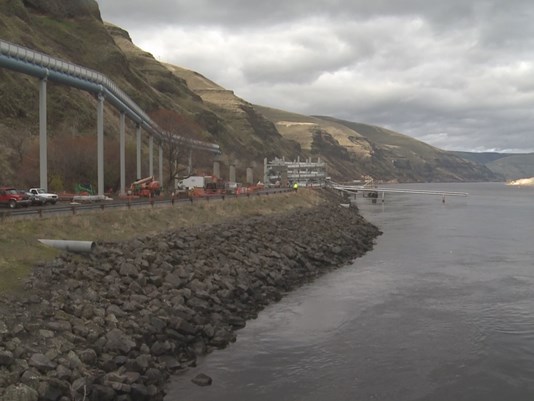forum
library
tutorial
contact

Council Mulling Issues Likely to Arise During
Coming Update of Basin Fish and Wildlife Program
by Staff
Columbia Basin Bulletin, January 19, 2018
|
the film forum library tutorial contact |

|
Council Mulling Issues Likely to Arise During
by Staff
|
 Anticipating issues that could be included in a nearly year-long process to update its Columbia River Basin Fish and Wildlife Program, the Northwest Power and Conservation Council Fish and Wildlife Committee at its meeting last week in Portland began to consider what might become important issues during that effort.
Anticipating issues that could be included in a nearly year-long process to update its Columbia River Basin Fish and Wildlife Program, the Northwest Power and Conservation Council Fish and Wildlife Committee at its meeting last week in Portland began to consider what might become important issues during that effort.
The 1980 Northwest Power Act directed the creation of the Council, an interstate compact agency with two representatives each appointed by the governors of Idaho, Montana, Oregon, and Washington.
The Act requires the Council to develop a program to "protect, mitigate, and enhance fish and wildlife, including related spawning grounds and habitat, on the Columbia River and its tributaries … affected by the development, operation, and management of [hydroelectric projects] while assuring the Pacific Northwest an adequate, efficient, economical, and reliable power supply."
The Act also says that the Council must update or amend the fish and wildlife program every five years, using the advice of federal, state and tribal fish and wildlife managers to take into account advancements in science. The Council must seek widespread public involvement in the formulation of regional power and fish and wildlife policies.
The Council will begin the process to amend its 2014 Fish and Wildlife Program this spring. Before that Council staff has suggested discussing issues that have arisen since the previous Program was completed. That discussion could give the entire amendment process some context as the Council prepares to invite amendment suggestions.
There have been 35 years of successes through Council funded fish and wildlife programs and studies, but overall "we have eluded our recovery goals," Patty O'Toole, program implementation manager, told the Fish and Wildlife Committee Tuesday, January 9.
Still, according to O'Toole and a January 3, 2018 Council memorandum, the 35 years of program development and implementation have yielded successes, including:
One question to consider is:
"After 35 years of water management and passage actions, are there additional hydrosystem protection actions that can increase salmon survival through the hydrosystem? Have survival benefits gained through hydrosystem protection actions been maximized so that additional opportunities of improvements in survival through the mainstem are minimal?" the memo asks.
Other questions are:
Montana Council member Jennifer Anders said that the Columbia River Treaty should be a consideration. "They are looking at flows throughout the system," she said.
"We've handed the ISAB two huge questions," said Oregon member Bill Bradbury. "How much detail will they give us?"
"In some ways we all know we will get information back (from the ISAB) that will be similar to what we've been hearing for 30 years," said Tony Grover, director of the Council's Fish and Wildlife division.
"But how much can we do?" Anders asked. "We have a court that's basically managing the river."
"There is a limit to what we can do," Grover said. "We just need to identify where we can make progress. We're way past the generalities at this point."
Bill Booth, Idaho member, said that fish and wildlife funding could be limited over the next couple of years, given the Bonneville Power Administration's budget constraints.
"Is there a way to better focus our efforts and energy on more specific places in the basin?" he asked.
"Yes, places that would give us a bigger bang, but we also need to evaluate and look deeper into where we've succeeded," said Guy Norman of Washington.
Given how much has been done, Booth suggested the Council "tell a better story" about its successes.
Nancy Leonard, fish, wildlife and ecosystem M&E report manager, said the staff has heard this before and they have worked with a public focus group to come up with ideas. Those ideas will be presented to the Committee at its February meeting, she said.
Fish and Wildlife staff also believes the Program will benefit from an update of the wildlife mitigation strategy, the memo says. They are currently preparing an assessment of progress toward the adopted wildlife losses in the Program.
For more information about the Council and its Fish and Wildlife Program go to https://www.nwcouncil.org/fw/program/2014-12/program/
Related Pages:
Agencies Outline NEPA/EIS Progress Evaluating Columbia/Snake River Uses, Improvements For Fish by Staff, Columbia Basin Bulletin 12/8/17
Federal Court Again Rejects Columbia Basin Salmon/Steelhead Recovery Plan; Orders New BiOp By 2018 by Staff, Columbia Basin Bulletin 5/6/16
learn more on topics covered in the film
see the video
read the script
learn the songs
discussion forum
